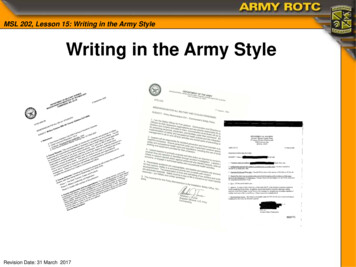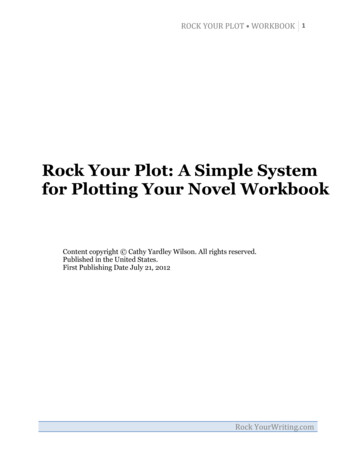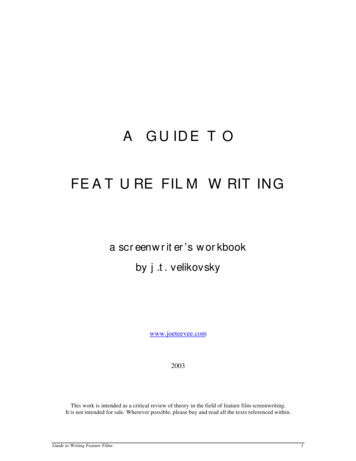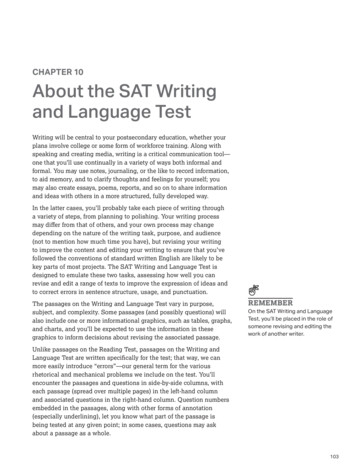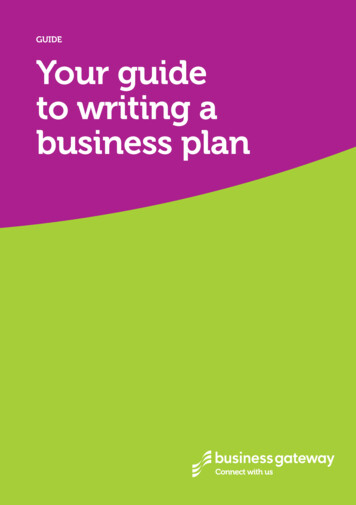
Transcription
GUIDEYour guideto writing abusiness plan
Whether you’re starting up or have already begun,a business plan is an essential tool. It keeps youon the right track. And, if used properly, it preventsunpleasant surprises, enables you to be flexibleand helps you adapt to changing circumstances.We understand that compiling a business plan can be quitedaunting. That’s why Business Gateway has developeda template. Using the template is an easy and efficient wayto focus on your business and get organised.This guide helps you complete the template. It sets outthe different sections a business plan should cover, includingfinancial forecasts.By using this guide to answer the template questions, you’resteered through the whole process, saving you time, effortand worry. Working this way, you get a comprehensive plan,ready for use. You can of course add appendices to give moredetails, for example, on research, evidence, analysis andother matters.
CONTENTS1. Executive summary2. Business details3. Business overview4. Business goals5. Target market6. Market overview7. Competitor analysis8. SWOT analysis9. Competitive advantage10. Sales11. Promotion12. Management team13. Staff14. Premises15. Equipment16. Suppliers17. Distribution3 Your guide to writing a business plan18. Transport19. Insurances20. Management informationsystems21. IT22. Legal23. Costs and pricing24. Risks25. Financial forecastsa. Start-up costsb. Personal survival budgetc. Sourcing financed. Profit and loss forecaste. Cash flow
1. Executive summaryIt’s a summary. So writing this section of the document usuallycomes last, after you’ve completed the other sections. Whenyou complete the other sections, you’ll find it prettystraightforward and quicker to write this section.In this summary you reiterate the highlights of sections2-29. You should also explain the purpose of the plan.For example, whether the document is intended for seekingfunding from lenders and investors or looking for newpartners. It could of course also be a strategic internaldocument.2. Business detailsIn this section you set out the details of your business.Give your business name. If it has a different trading name,include them both.Your business address goes in here. For example, does itoperate from a home, office, retail unit or manufacturingspace? Or is it a mobile business or something different?Enter your own contact details.4 Your guide to writing a business plan
Mention the legal structure of your business. For example,sole trader, partnership, limited company, limited liabilitypartnership, social enterprise or Community Interest Company.Insert the date your business was or will be established.If you’ve registered your business, you may be liablefor corporation tax, so mention the registration date.Your Business Registration Number goes in here. If you’renot registered, just put ‘Not Applicable’.Have you registered for VAT? If so, mention the date whenyou did so and then your VAT number. If not, put in‘Not Applicable’.Do you have an online presence? For example, a website,Twitter handle, Facebook page or Instagram account. Mentionthem all here.3. Business overviewIf you’re a start-up, this is where you explain your idea, and whatyour proposed products or services are.5 Your guide to writing a business plan
If you’re an existing business, explain what the business does.It may be useful to include a bit of background. For example, howyou got to this position. Did you buy the business or are youthe original owner? And do you own intellectual property, suchas a patent or trademark?In either case, explain why the business should or does exist,other than simply to generate profit for you.4. Business goalsDescribe what you want to achieve in the coming year.This can be a financial or a non-financial goal.If you’re a start-up, you may simply want to break-even bya particular date, make a specific amount of profit, get a setnumber of clients or have your product stocked in particularstores.If you’re already trading, you may want to break into anothergeographical market, launch new products or servicesor increase (or decrease) your workforce.In either care, try to be precise. Use SMART objectives –specific, measurable, achievable and realistic. Then you can tell6 Your guide to writing a business plan
when you have reached them. Or they give you a benchmark,so that you know what to change or improve in orderto achieve it.After that, describe where you see your business in 3-5years’ time. These longer-term objectives don’t need to beso precise. However, the more precise, the easier they areto plan for.5. Target marketSay what type of customers you’re aiming at. For example,consumers, businesses or organisations.When you’re aiming for consumers, include their ageand gender.When aiming for businesses or organisations, mention the sizeof their business.What about their location? For example, where they liveor work. State it here.Describe the key characteristics of your customers.7 Your guide to writing a business plan
List what they care about most when it comes to your productor service. For example, what influences their buying habits –price, quality, speed of delivery, environmental issues or ethicalconcerns.What are their reasons for buying from you? For example,why they wouldn’t buy the same product or service fromsomewhere else.You can get this type of information from a variety of sources.For example, marketing questionnaires, surveys, focus groupreports, online research, social media, testimonials fromcustomers and personal experience.If you target different customer groups or segments, you mayhave to give several target profiles.6. Market overviewThis section shows how much you know about the marketin which you operate. Try to be precise and use yourexperience or research to complete this section. Please visitbgateway.com/your-sector for more information about eachmarket.8 Your guide to writing a business plan
Just as in the target market, many sources provide marketdata. You can also visit trade fairs or conduct mystery shoppingto get more information.Describe the size of the market. What is the market outlook –do you see it growing in years to come? What are the keyfeatures and are there any specific trends?7. Competitor analysisIn this section, look at outlining the main competition. Whoare your main competitors? What are their products andprices? You should gather up-to-date information on at leastthree competitors. That may take some time, if you haven’talready done so. For this purpose, you can study competitorwebsites. You can also buy and try out their products.You might want to consider the following:» Three competitor names and locations.» What products or services do they sell?» What do you see as the strengths of their business?» What are their weaknesses?» What prices do they charge?» If you know, mention their market share or position.» If they have one, describe their reputation.9 Your guide to writing a business plan
8. SWOT analysisA SWOT analysis iis a good way to reveal insights and flag uprisks, whether you’re starting or growing the business. It alsohelps in the future, when you’re assessing your situation and haveto change your plan.Strengths and weaknesses are internal – about your business.Opportunities and threats are external – factors that affect yourbusiness.Describe your strengths. For example, you have a superiorquality of product, specialist team or wide range of services.Mention your weaknesses. For example, a lack of financeor staff, dependency on one supplier or reliance on one maincustomer.List the opportunities. For example, an increasing marketfor your product, clear gap in the market, new technologyor business partnership.Don’t forget threats. For example, you could face increasedcompetition, an economic downturn or a change inlegislation, which will make trading more difficult for you.10 Your guide to writing a business plan
9. Competitive advantageThis section shows you’re clear about why you feel yourbusiness can survive profitably in a competitive market.»»»»What do you see as a gap in the existing market?How do you differ from the competition?What is your unique selling point? Any points of difference?What proof do you have to make each claim? If you don’thave any supporting evidence then you won’t be able toclaim it and will need to find something else to justify yourcompetitive advantage.10. SalesDescribe how you sell your product or service. For example,on the internet, through a retail outlet, or both. Also highlightwhether you’re selling to individuals or organisations.Or if you’re using or planning to use an agent.This should be a general description. Later in the form, you haveto calculate the costs involved in selling, including managementtime or commission fees.11 Your guide to writing a business plan
11. PromotionThis section shows how you promote your business.You should say how you inform customers and persuade themto buy your product or service. For example, through socialmedia, advertising, direct mail, exhibitions and conferences,websites and PR.Promotion costs are measured in money and time.12. Management teamIn this section you mention the key people in your business.It may only be you, but you could also have a managementteam, in which case you should give profiles of all managers.Management team:» List the names of your management team. Mention theirresponsibility in your business. For example, in production,sales, marketing, finance or administration.» Who do they report to?» Do they have experience relevant to the business?» Do they bring investment to the business?» What key skills do they bring to the business?You may want to have somebody who would be in chargeshould anything happen that prevents you from fulfilling yourown role. You can include this in section 24 when youdescribe risks.12 Your guide to writing a business plan
In addition, you may have advisers and access to supportservices, for example through business networks, includingaccountants, independent financial advisers and tax advisers.You can also outsource business functions. For example,book-keeping or secretarial work.Advisers and support services:» List the names of you advisers and support servicesuppliers.» Describe the advice, services or support they supply.» Mention their contact details.MethodDetailSuccess will bemeasured byCompetitorsusingmethod?CostsPrint advert inlocal freecommunitynewspaper½ page adNumber ofpeople phoningup for moreinformationNo 50Advert inGumtreeDisplay adNumber ofpeople phoningand bookingservicesYes1 hour takingphotos and writingand posting the ad(calculate the costof one hour ofyour time)13 Your guide to writing a business plan
13. StaffHere you should state how many employees you haveor need, in addition to the management team mentionedin the previous section. Say whether they have or need anyspecial skills. Are there minimum national standards/employment regulations which you need to bear in mind?14. PremisesDescribe in detail what premises you have or are lookingfor. For example, a home, rented or bought property. If there’sa lease involved, mention the length of lease. List all the relatedcosts. For example, rent, mortgage, gas, electricity, telephoneor furniture purchases.It’s also useful to state whether you’ll be considering changesin the future.What is the advantages / disadvantages of your currentlocation, if the business is to grow, change or move?15. EquipmentThis section shows what resources you have or needin terms of equipment and machinery. There’s room forthree resources – X, Y and Z, but mention more resourcesif they’re needed.14 Your guide to writing a business plan
» What is the resource you need?» Do you already own it?» What’s the current value? There are separate boxes to saywhat the value is if the resource is bought, updatedor replaced.» When do you need the resource?16. SuppliersThis section lists your main three suppliers. A goodrelationship with suppliers is essential for success, as it shouldmean timely delivery, good quality and efficient cash flow.»»»»»»Give the names of the suppliers.What products or services do they supply?What is the number of days credit they offer?Describe your reasons for choosing them.Are there any risks?Do you have a tendering process?17. DistributionHere you describe how your customers actually get your15 Your guide to writing a business plan
products. For example, by post, courier, wholesaler, distributoror retail outlet.If you’re selling a service, explain how it’s delivered to yourcustomer. For example, by you in person or an intermediary.Mention the costs to you of using these distribution channels.18. TransportDescribe the transport you need. For example, for goods,equipment or yourself, to meet clients. Mention who conductsthe transport, how you travel and what it costs.19. InsurancesThis section lists the various policies you need. For example,insurance to cover public liability, goods in transit, buildingsand contents, employer’s liability, product liability, vehicle, legalexpenses or stock.You should take professional advice on insurance matters.For example, on what policy suits the size of your businessor getting the best deal. You can also explain how updatingand renewing policies affect your cash flow.There’s room for three insurances but mention more policiesif they’re needed.16 Your guide to writing a business plan
Give the name or the type of insurance.»»»»Who supplies it?What is the renewal date?What does it cost?Could you be getting a better deal from a differentinsurance company?20. Management informationsystemsHere you described what management information systemsyou have in place. For example, on book-keeping, sales data,stock and quality control. You should also explain whether theycan cope with any proposed growth of your business.21. ITDescribe the IT systems you hav
a business plan is an essential tool. It keeps you on the right track. And, if used properly, it prevents unpleasant surprises, enables you to be flexible and helps you adapt to changing circumstances. We understand that compiling a business plan can be quite daunting. That’s why Business Gateway has developed . a template. Using the template is an easy and efficient way to focus on your .
